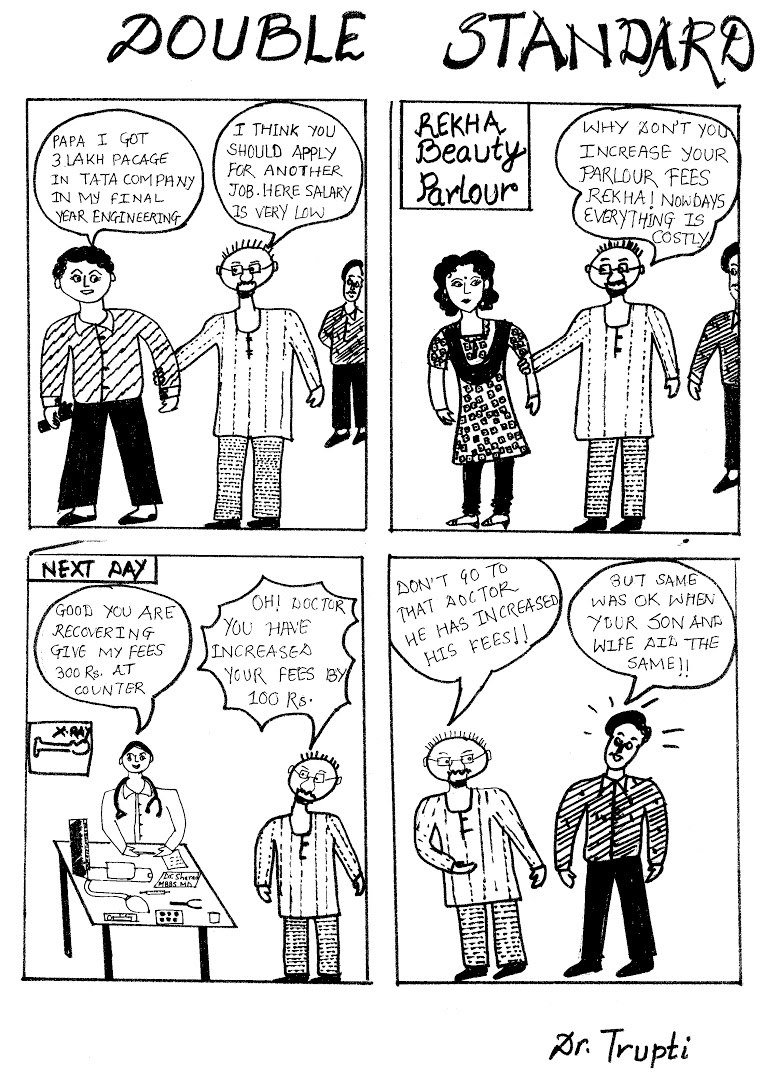
Doctors drawing for better communication with patients: Why this may be more than a passing fad
Doctors, including the ones who cannot draw well being enthusiastic about learning to draw to better doc-patient communication: If the idea sounds crazy, you are probably not the only one.
But when Sharad Sharma-as part of the social venture, Grassroots Comics went to AIIMS Delhi recently to conduct a workshop, he was flabbergasted. The workshop, meant to help docs learn the art of comics as a way to communicate with patients, was overbooked. A few ‘aspirants’ had to be turned away.
ABCD- Anybody can draw
Sharad believes that as long as you can get your point across through drawing, it’s a success. In other words, you don’t exactly have to be a Dali to pull it off.
Encouraged by Sharad to focus more on the story than the art, the doctors brought to life-using four panels and simple sentences the stories of red tapism and other troubles in their profession. The issues that got represented in the comics ranged from the thankless nature of the job to patient’s apathy and faith healing.

One doctor’s effort at the workshop
Reasons why this makes a lot of sense
Though not completely visual in nature, the comic strip is a medium which is predominantly visual. And many aspects that make visual communication successful can be attributed to it as well. Like these:
1. The brain is wired to process visual information better, faster
About 90 percent of all information that we consume comes to the brain in the visual format. This is a basic tenet of being human, true even if you were living in sub-Saharan environs where hoardings are non-existent. Centuries of evolution has resulted in our brains being hardwired to make sense of visual information more effectively than other forms of communication. After all, the predator who came from behind the bushes to attack our ancestor didn’t come with a written text held in front that said ‘Run for thy life!’
Also, the human brain is naturally set to discern visual data-the fact that 40 percent of the nerve fibres to the brain are connected to the retina is an indicator. This facet of the brain is evident when we think of how prone we are to notice such things as facial cues, traffic signs and visual ads more than textual content in our surroundings.
And visual info is processed faster by the grey matter as well. Faster not just in any arbitrary sense either.
Visuals are said to be processed a whopping 60,000 times faster compared to text. It takes about 0.25 seconds to absorb a bit of verbal information. The exact time taken to comprehend an equivalent text-based information is not yet measured-as far as we know. But it’s safe to assume that it will be in a different category altogether.
2. The predominance of visual over text-based communication since the dawn of humans
The emergence of text-based communication among humans is considered as a relatively recent development in the history of our species. While human communication is believed to have existed for 30,000 years text-based communication entered the picture(literally) just around 3,700 years ago. This means that for an awfully long time, we have been communicating just visually-giving our brains plenty of time to fine tune our visual sensibilities.
3. The lesser attention span we super-moderns have makes visual info more relevant
Living in the age of hyper-commercialism, the average attention span of a customer is said to be eight seconds. That’s a drop from the 12 seconds which was recorded in 2000. Possibly, we are gonna see even further drops in the coming years-don’t ask us what the state of the world will be when it’s down to something like 0.00002 seconds. The bottom line is that our attention span could be lesser than that of a goldfish(the adorable aqua-beings can hold their attention for nine seconds). In such a scenario, what better way to communicate than visually?
4. What the social media attests
For social scientists(as well as brands) social media has proven to be a veritable lab in which to make significant observations. One such observation relevant to the human affinity for visual content is that audience engagement on Instagram is 58 times higher than that on Facebook. Remember that Instagram is a more visual oriented platform than Zuckerberg’s book.
Then, there is also the fact that most apps and websites rely on visual information with minimal text to communicate with the audience. Not necessarily because the people behind such companies are visual artists but because that’s an effective way to communicate in the (too)modern world.
5. What the result of the AIIMS workshop shows
Adding to all the reasons from the pre-historic times onward which back the validity of visual communication is what happened after the workshop in AIIMS. Pleased with the endeavour, the doctors have requested for more workshops of the kind. Apparently, happy with the idea of expressing in such a creative manner, the doctors are ready to explore the medium more.
Many of the posters the doctors created are already displayed in the hospital so that they can be seen by the patients. Handing out copies of drawings to patients to educate them is also happening. That’s what came about with the comic on Rashtriya Arogya Nidhi which was created by Vivek Kumar Singh, Medical social service officer.
Image credits: scroll.in